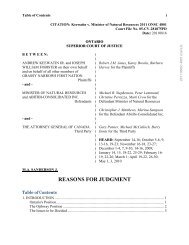COURT OF APPEAL FOR ONTARIO
COURT OF APPEAL FOR ONTARIO
COURT OF APPEAL FOR ONTARIO
You also want an ePaper? Increase the reach of your titles
YUMPU automatically turns print PDFs into web optimized ePapers that Google loves.
Page: 89<br />
(2) Did the motion judge err in deciding that Purvis enjoyed a personal<br />
license rather than a prescriptive easement?<br />
[220] Before addressing the appellant‟s specific complaints about the motion judge‟s<br />
findings, we begin by observing that the appellant does not take issue with the motion<br />
judge‟s articulation of the law on prescriptive easements. The appellant‟s point of<br />
departure from the motion judge concerns how the motion judge applied the law to the<br />
facts as he found them. Thus, the appellant‟s complaints relate to the motion judge‟s<br />
findings of mixed fact and law. These findings fall more towards the factual end of the<br />
spectrum, and significant deference must be accorded: Bell Canada v. Plan Group, at<br />
para. 27.<br />
[221] Counsel for the appellant submits that there was no evidence to support a finding<br />
that Purvis had express or implied permission for her use of the lands. He further submits<br />
that both Purvis‟ and Little‟s evidence supports a finding that Purvis walked the claimed<br />
easement lands in a continuous, uninterrupted, open, peaceable manner, and with the<br />
knowledge of, and without objection from, the owner for 20 years.<br />
[222] We would not interfere with the motion judge‟s findings on this issue. The<br />
evidence before him supported the inference that Purvis and her husband were permitted<br />
to walk on the adjoining land as a neighbourly gesture without being treated as<br />
trespassers. The motion judge was entitled to draw the inference from the evidence before
















